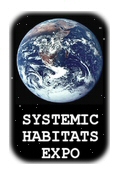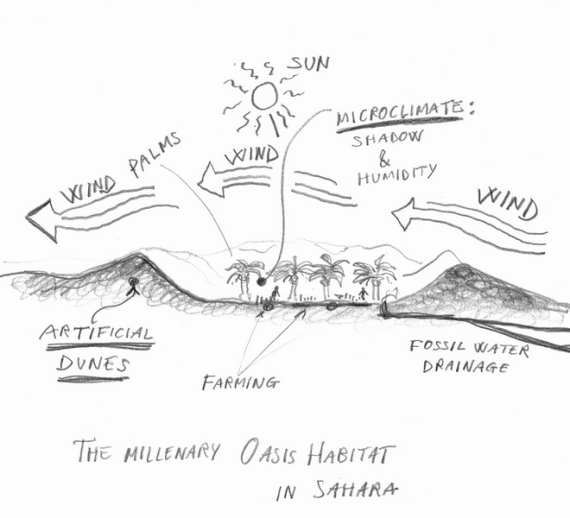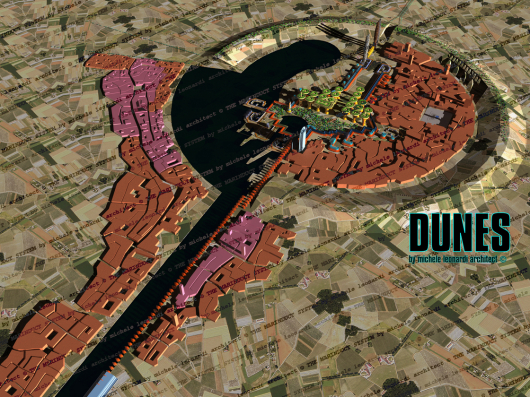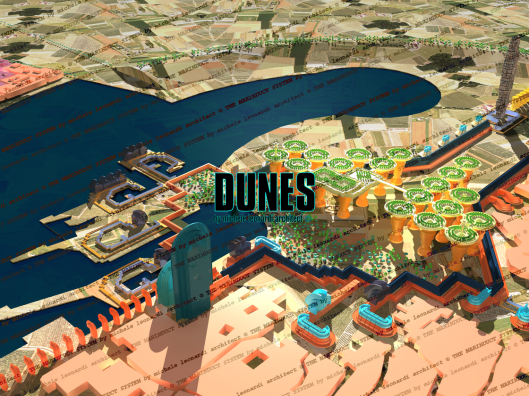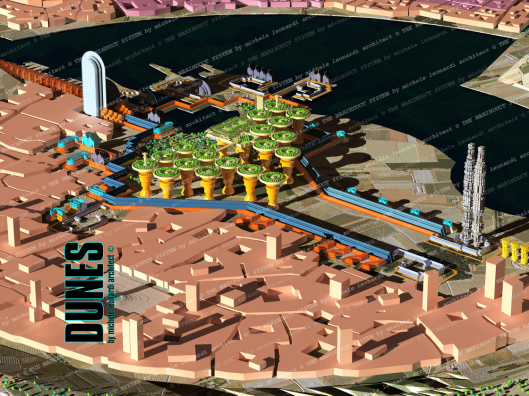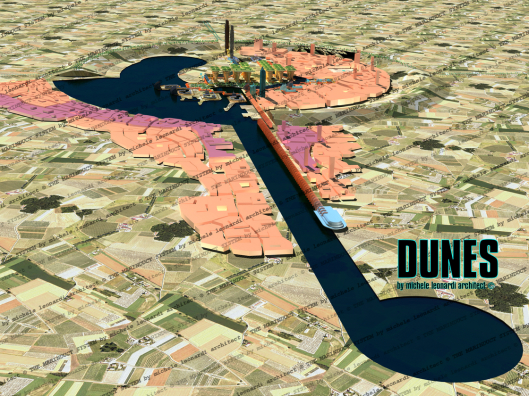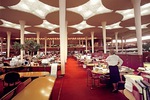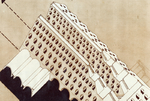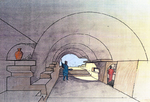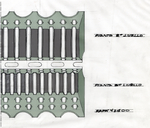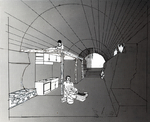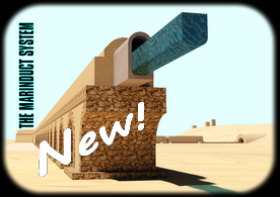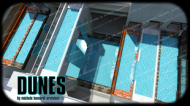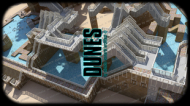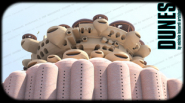الكثبان
D U N E S
THE OASIS HABITAT,
FOR TERRAFORMED DESERTS
by Michele Leonardi architect © 2002; 2007; November 2011
THE OASES
are not a natural phenomenon, as most people think it, because they are the product of a millenary culture, the result of a long adaptation of some people to extreme living conditions.
In the oasis everything is artificial, like the drainage and administration of water-resource, like the palm wood that create a microclimate. Even the dunes are artificials, always to create a microclimate.
The oasis: a perfect example of long-term strategy, real sustainable architecture.
In the following project, The Oasis Habitat consists of 4 parts:
1 - An artificial dune that protects against the dominant winds, with inside craft and industrial activities.
2 - An artificial lake which creates a microclimate, and a fish farming.
3 - The houses in clay, or adobe, or pisé, or in géopolymer-bricks, low cost and ecofriendly.
4 - The civic center with tall buildings geopolymer cement, in low environmental impact.
all rights reserved © Michele Leonardi architect
H D s e l e c t e d p i c t u r e s i n P D F :
2) "Ctrl+L" key for full screen mode.
3) Mouse scroll, or flesh key or other, to view the different pictures:
DUNES - The Oasis Habitat - by MLA-signe[...]
Documento Adobe Acrobat [10.8 MB]
L'HABITAT OASIS
Les oasis ne sont pas un phénomène naturel, comme la plupart de gens pense, car au contraire elles sont le produit d'une culture millenaire, le résultat d'une longue adaptation par certaines peuples à des conditions de vie extrêmes.
Dans l'oasis tout est artificiel: le drainage soubterrain et l'administration de la precieuse ressource "eau", les palmiers qui créent un microclimat, même les dunes sont artificielles, toujours au but de créer un microclimat.
L'oasis: un parfait exemple de stratégie à long terme, réelle architecture durable.
Dans ce projet, l'Habitat Oasis est composé par 4 parts:
1 - Une dune artificielle qui protège contre les vents dominants, au sein du quel il y a les activités artisanales et industrielles.
2 - Un lac artificiel qui crée un microclimat, et avec de la pisciculture.
3 - Les maisons en argile, ou en adobe, en pisé, ou en briques géopolymère, pas chers et ecosoutenables.
4 - Le centre civique avec de grands bâtiments en ciment géopolymère, à faible impact environnemental.
Bibliography
"Sahara - Giardino sconosciuto", by Pietro Laureano (architect and town planner), Florence, Italy, 1989.
"Giardini di pietra - I Sassi di Matera e la civiltà mediterranea", Pietro Laureano, Turin, Italy, 1993.
"La Piramide Rovesciata - Il modello dell'oasi per il pianeta Terra", by Pietro Laureano, Turin, Italy, 1995.
"Jardins de pierre : Les Sassi de Matera et la civilisation méditerranéenne", Pietro Laureano, Presses Universitaires de Vincennes, France.
"Water Conservation Techniques in Traditional Human Settlements", by Pietro Lureano, COPAL Publishing, 2013.
"Natural Energy and Vernacular Architecture: Principles and Examples with Reference to Hot Arid Climates", by Hassan Fathy, Walter Shearer and Abd-el-rahman Ahmed Sultan, 1986.
"Hassan Fathy: construire avec le peuple", by Hassan Fathy. Italian edition: "Costruire con la gente - Storia di un villaggio d'Egitto: Gourna".
"La casa araba d'Egitto", Adelina Picone, Jaka Book, Milan, Italy, 2009.
"Tunisia - Il recupero delle città oasi", by L. Anversa, V. Bentivegna, L.V. Ferretti, A. Filpa, A. Lacava, Gangemi Editore, Rome, Italy, 1990.
"Il manuale tematico della terra cruda", Maddalena Achenza and Ulrico Sanna, D.E.I., Rome, Italy, 2006.
"Terre crue : Technique de construction et de restauration", by Bruno Pignal, Editions Eyrolles, Paris, France, 2005.
"Handbuch Lehmbau: Baustoffkunde, Techniken, Lehmarchitektur", by Gernot Minke.
"Manual de construcción con tierra", by Gernot Minke.
"Earth Construction Handbook - The Building Material Earth in Modern Architecture", by Gernot Minke.
"Buildings without Architects - A Global Guide to Everyday Architecture", by John May.
"Architetture di terra in Italia. Tipologie, tecnologie e culture costruttive", Bertagnin Mauro, Mungiguerra Clelia, Achenza Maddalena.
"La decrescita prosperosa dell'edificio. Architecture from high tech to low cost", Morabito Giovanni, Bianchi Roberto.
"Habitat e architetture di terra. Le potenzialità delle tradizioni costruttive", a cura di F. Storelli, AA. VV.
"Involucro bioclimatico e solare", by Pasquale Cascella, Chandra Ed., Rome, Italy, 2008.
"Bioclimatica: storia, tecnica, architettura", by Pasquale Cascella, Chandra Editrice, Rome, Italy, 2011.
"Geopolymer Chemistry and Applications", by Joseph Davidovits, Institut Géopolymère de Saint-Quintin, France, 2013, 3rd Edition.
the evolution of an idea:
provided it is not the usual boring
mannerism of bad copying,
a project is a good project
if it can generate a new project:



